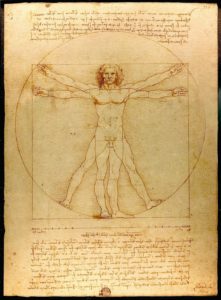Leonardo da Vinci’s Vitruvian Man
Over my recent holiday travels, I read Leonardo da Vinci by Walter Isaacson. The universe guided me to read this book. A year ago, I watched a documentary featuring Walter Isaacson on TVO. Just after that, I saw someone reading the book. They said they found it amazing. Just prior to my vacation, I saw the book on sale and bought it. I picked it up to read, then reached into my bag and found a business card to use as a bookmark. The business card had Vitruvian Man on it!

Isaacson’s book is based on 1400 pages of Leonardo’s notes preserved to this day, 500 years this year from his date of death. As I read the book, I understood the synchronicity. Currently I am enhancing my intuitive abilities by adding more diagnostic and healing techniques. Leonardo greatly enhanced our knowledge of the human body. He used dissection of bodies and his amazing artistic abilities to create dimension to our awareness of many aspects of the human body. Artists and healers alike still use these anatomical drawings today.
Vitruvian Man
Leonardo and many of his contemporaries drew Vitruvian Man, aptly named after a Roman architect. This man, Vitruvius, believed that the proportions of man were analogous to those of a well conceived temple and to the macrocosm of the world. Vitruvius lived 1500 years prior to the information being reinterpreted in the Renaissance time of Leonardo. Vitruvius felt there was a way to put a man in a circle and square in order to determine the ideal proportion of a church.
In a temple there ought to be harmony in the symmetrical relations of the different parts to the whole. In the human body, the central point is the navel. If a man is placed flat on his back with his hands and feet extended and a compass centered at his navel, his fingers and toes will touch the circumference of a circle thereby described. And just as the human body yields a circular outline, so too a square may be found from it. For if we measure the distance from the soles of the feet to the top of the head and then apply that measure to the outstretched arms, the breadth will be found to be the same as the height, as in the case of a perfect square. (Vitruvius, Ten Books on Architecture, bk. 3, para. 3; Morgan translation, 97)
Leonardo’s Version
This sounds very clear, but nobody had actually made a precise drawing that conformed with these ideas. Leonardo created the version we know. Some have called it an idealized self-portrait with a metaphysical air representing all of humanity.
In Leonardo’s drawing of Vitruvian Man, we see so many of his ideas come together in his imagination – most notably the transformation of geometric shapes and a concept combining math and art that was known as “the golden ratio” or “divine proportions”. Adding to that, we see the mathematical challenge of squaring the circle, and the analogy between the microcosm of man and the macrocosm of the earth. Leonardo’s Vitruvian Man embodies a moment where art and science combine to allow mortal minds to probe timeless questions about who we are and how we fit into the grand order of the universe. (Isaacson, Leonardo da Vinci, 158)
I found the breadth of information and detail known about Leonardo fascinating. I read the entire book during my vacation. The knowledge Leonardo shared through his creations and studies is amazing. We as humans continue trying to reach further all the time in order to feel at peace within our lives in our divine lifetime.
